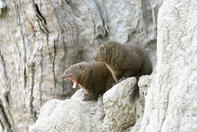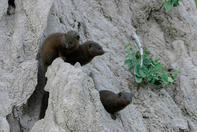Homeranges
Dwarf mongoose utilize homeranges of about 1 km². Within the area, they require a network of termite mounds, with exposed ventilation holes, and other small refuges, like shallow burrows or tree hollows, to act as nighttime stopovers and bolt holes when threatened by predators.

During the day, dwarf mongoose forage through piles of leaf litter or under fallen vegetation and progressively work from one sleeping sight to the next covering the extent of their homerange in a rotation lasting about three weeks.
In this way, they are able to reduce the pressure on their food resources and remain in their homerange on a sustainable basis. Dwarf mongoose are territorial but will defend sleeping sites more vehemently than territorial boundaries.
Territorial markers include both cheek and anal gland secretions and sleeping sites are obvious by the accumulation of the entire group’s scat in a nearby latrine. Vertical objects are collectively marked by reversing backwards up the post to get the scent as high as possible.
The smell lasts about as long as it takes for the group to circumnavigate the homerange and may also serve as a marker to the group as to when last they visited the area. If a neighbouring group attempts to overtake a particular sleeping site, the groups will mutually charge one another aggressively with bristled tails and biting advances and the larger group generally displaces the smaller, without injury, and thus quickly settles the dispute.
Rank and File

Rank in the group is determined by age with the alpha pair, that remains mated for life, dominant to all others. This rule varies with very young babies, which outrank even the higher ranked adults. Females dominate males and the alpha female is even the largest in size of all the members.
Subordinate members always defer to their superiors, especially where food access is concerned and they indicate their submission by crouching low or rolling onto their backs while twittering softly. Status can be improved by performing important functions like babysitting especially regularly. Immigrant animals, which possess fresh genes quickly outrank resident mongoose although joining a new pack may first be fraught with weeks of difficulty to gain acceptance.
By Megan Emmett